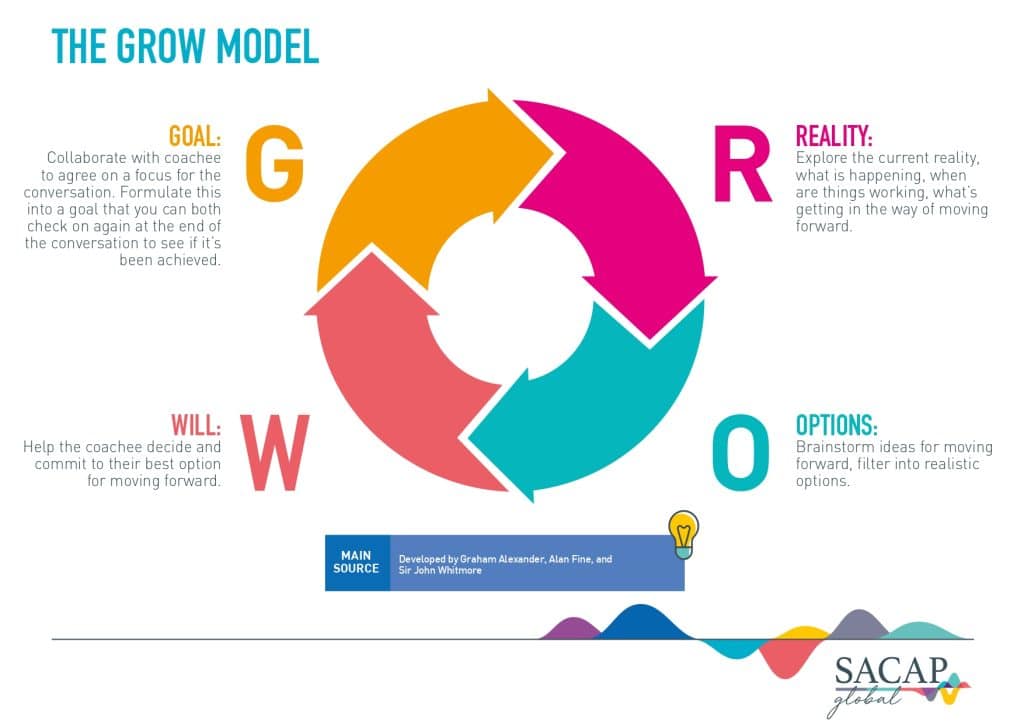Coaching models are helpful tools that provide a framework for coaching sessions. Specifically, they assist in enabling self-development and positive growth. The acronym in GROW model stands for Goals, Reality, Options / Obstacles and Will / Way Forward. It’s a very useful coaching tool that’s widely used across the industry to direct coaching conversations.
What is the Purpose of Coaching?
The aim of coaching is to assist someone to achieve their goals. These may be within their personal or professional lives. Coaching utilises a client’s existing strengths to enable them to achieve a goal. The coaching process builds a client’s awareness of themselves and their situations, helping them to take action to make the changes they want. A coach is an external sounding board, who holds a client accountable while encouraging them to flourish. When things become challenging, coaches assist in keeping someone motivated and provide a space to discuss strategies to overcome obstacles.
What is the GROW Model for Coaching?
The GROW coaching model was initially outlined in the book Coaching for Performance by Sir John Whitmore. He developed it in conjunction with Graham Alexander and Alan Fine. It was originally used in business coaching but is now widely used in all forms of coaching.
The GROW model is applicable to any opportunity or challenge. It aims to help coaching clients set realistic goals and then assist them to achieve them. It does this by asking a series of open-ended questions. These are designed to prompt a client to become more self-aware, and self-reflective and to get them to engage in self-analysis.
The GROW Model
- GOAL: The first step is to set personal and/or professional goals. They should be goals which are specific, able to be measured, attainable, realistic and timebound (SMART).
- REALITY: In order to achieve a goal, it’s necessary to understand your current context. This means understanding exactly where you are and realistically what your capacity, strengths and weaknesses are. This will assist in planning how to attain your goal.
- OPTIONS (OBSTACLES): This stage requires brainstorming. The purpose of which is to assess the gap between where you are and where you need to be. And within this process what choices are available to you to bridge this gap. Essentially during this step, potential challenges are considered and creative ways to overcome them are thought through.
- WILL (WAY FORWARD): Here you choose which options you want to pursue.Strategies to achieve goals are formulated. Part of this plan is to set up both milestones and an accountability structure. This is to assist with keeping on track and thereby better enabling the successful achievement of goals.
The GROW model is a simple tool that is easy to understand and user-friendly. However, this does not mean that it is easy. Its simplicity does not negate the reality that achieving goals requires hard work, determination and focus as well as tenacity. While the GROW model will require effort, it is extremely effective in achieving outcomes, so well worth the time spent.
Where to use the GROW Model
The simplicity and effectiveness of the GROW model means that coaches and individuals can use it. Therefore, it can be utilised in both professional and personal contexts.
Professional Use
One can use the GROW model as a framework to set clear targets within a workplace environment and motivate teams. It can help define an individual’s role and responsibilities within a team. It can also be used to help someone realise their potential and assist them in creating a successful work strategy.
Personal Use
Working through the GROW model stages is one way of setting personal goals and reaching milestones. It is an excellent way to be more intentional in building healthy habits in one’s life. Furthermore, it can assist in highlighting what your own goals actually are. The WILL / WAY FORWARD stage is particularly good at helping to keep you focused and motivated. This means you’re more likely to stick to your resolutions.
Intro to Coaching
A coaching short course will help you cover the foundations of coaching. Explore key aspects of coaching and learn how it can support personal and professional development. Find out more about the 40-hour Intro to Coaching short course.
Coaching Skills for Managers
Coaching courses are an excellent way to improve management skills. It is one of the ways that a manager can bring out the best in individuals. And thereby, enhancing their team’s productivity and success. It is also an effective way to develop one’s self-belief, communication skills and motivation. Find out more about the 12-week Coaching Skills for Managers short course.

